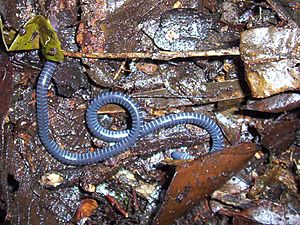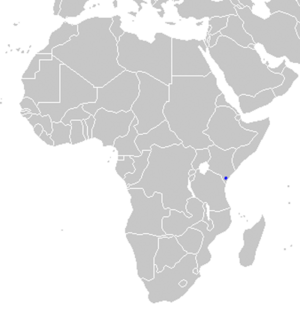Boulengerula taitana facts for kids
Quick facts for kids Boulengerula taitana |
|
|---|---|
 |
|
| Conservation status | |
| Scientific classification | |
| Kingdom: | |
| Phylum: | |
| Class: | |
| Order: | |
| Family: | |
| Genus: |
Boulengerula
|
| Species: |
B. taitana
|
| Binomial name | |
| Boulengerula taitana Loveridge, 1935
|
|
 |
|
| Range highlighted in blue. | |
| Synonyms | |
|
|
The Boulengerula taitana, also known as the Taita African caecilian, is a special type of caecilian. Caecilians are amazing creatures that look a lot like worms or snakes, but they are actually amphibians! This means they are related to frogs and salamanders.
This unique animal belongs to the family called Caeciliidae. It lives in Africa, especially in countries like Kenya.
Contents
What is a Caecilian?
Caecilians are amphibians that don't have legs. They have smooth, often slimy skin. Most of them live underground, burrowing through the soil. They are often mistaken for large worms because of their long, slender bodies.
Where Does it Live?
The Taita African caecilian lives in subtropical or tropical forests. These are warm, wet places with lots of trees and plants. They prefer to live in the damp soil of these forests, where they can easily burrow and find food.
Habitat in Kenya
Specifically, the Boulengerula taitana is found in the Taita Hills region of Kenya. This area is known for its unique wildlife and lush forests. The map in the infobox shows the blue area where they live.
How Does it Reproduce?
Unlike many amphibians that lay eggs directly in water, the Taita African caecilian has a unique way of laying its eggs. They lay their eggs in a special foam nest. This nest is usually found near or in water, helping to keep the eggs moist and safe until they hatch.
Why is it Important?
The Taita African caecilian is an important part of its ecosystem. As burrowing animals, they help to aerate the soil, which is good for plants. They also help control insect populations by eating them. Studying these unique amphibians helps scientists understand more about biodiversity and how different species adapt to their environments.
See also

- In Spanish: Boulengerula taitana para niños


